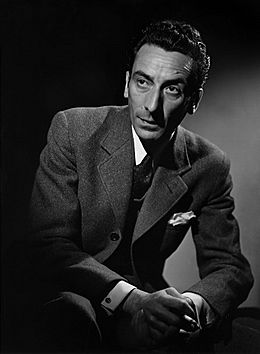Enrique Santos Discépolo facts for kids
Quick facts for kids
Enrique Santos Discépolo
|
|
|---|---|
 |
|
| Background information | |
| Birth name | Enrique Santos Discépolo |
| Born | 27 March 1901 Buenos Aires, Argentina |
| Died | 23 December 1951 (aged 50) Buenos Aires, Argentina |
| Genres | Tango, milonga |
| Occupation(s) | Musician, composer, songwriter |
| Instruments | Piano, Bandoneón, vocals |
| Years active | 1920s–1951 |
| Labels | El Bandoneon |
| Associated acts | Astor Piazzolla, Carlos Gardel, Francisco Canaro |
Enrique Santos Discépolo (nicknamed Discepolín) was a famous Argentine musician and composer. He was born on March 27, 1901, and passed away on December 23, 1951. He wrote many well-known tango and milonga songs. Some of his most famous tangos, like Cambalache, were sung by important artists of his time, including Carlos Gardel. Besides music, Discépolo was also a filmmaker, actor, and screenwriter.
Contents
Life of Enrique Discépolo
Enrique Santos Discépolo was born in Buenos Aires, Argentina. From a young age, he loved the arts. He first tried acting and writing for the theater. He had some success with these, but he eventually decided to focus on tango.
His older brother, Armando, had helped raise Enrique after their parents died when Enrique was very young. Armando was not sure about Enrique's choice to write popular music at first. But Enrique followed his passion.
In 1928, one of his tangos, Que vachaché, became very popular. Its lyrics quickly spread across the country. Later that year, the actress and singer Tita Merello helped make Que vachaché even more famous, just like his other hit, Esta noche me emborracho. Also in 1928, he met Tania, who became his partner for the rest of his life.
Enrique Discépolo continued to gain fame. In 1934, he wrote Cambalache. The words of this song described the world around him. Many Argentines still quote Cambalache today because its message feels true even now.
Enrique Discépolo died from a heart attack on December 24, 1951.
Discépolo's Music Style
Discépolo was a very creative songwriter. He could write songs that were:
- Ironic and moralistic: Like Yira... yira... and Cambalache. These songs often made people think about life and society.
- Romantic: Such as Sueño de juventud.
- Sarcastic: Like Justo el 31 and Chorra.
- Expressive: For example, Soy un arlequín and Quién más, quién menos.
- Passionate: Like Confesión and Canción desesperada.
- Nostalgic: Such as Uno and Cafetín de Buenos Aires.
His tango songs, like many others, often used words from lunfardo. Lunfardo is a special slang used in Buenos Aires. This can make his lyrics a bit tricky to understand for people who don't know the slang.
Famous Songs by Discépolo
- Infamia ("Infamy")
- Que vachaché ("What Will You Do?")
- Yira... yira...
- Que sapa señor ("What's New, Sir?")
- Cambalache ("Junkshop")
- Sueño de juventud ("A Young Man's Dream")
- Justo el 31 ("Right on the 31")
- Chorra ("She-Thief")
- Soy un arlequín ("I Am a Harlequin")
- Quién más, quién menos ("Who More, Who Less")
- Confesión ("Confession")
- Canción desesperada ("Desperate Song")
- Uno ("One")
- Cafetín de Buenos Aires ("Buenos Aires Cafe")
Films Directed by Discépolo
Enrique Discépolo also directed or co-directed several films:
- Four Hearts (1939)
- Caprichosa y millonaria (Petty and Millionaire) (1940)
- Un señor mucamo (1940)
- By the Light of a Star (En la luz de una estrella) (1941)
- Fantasmas en Buenos Aires (Ghosts in Buenos Aires (1942)
- Candida, Woman of the Year (1943)
- The Fan (1951)
See also
 In Spanish: Enrique Santos Discépolo para niños
In Spanish: Enrique Santos Discépolo para niños

